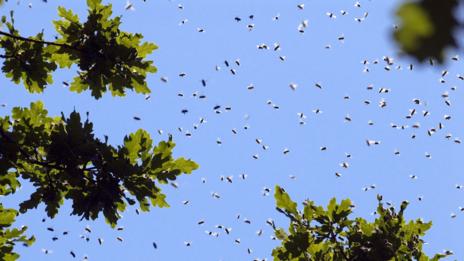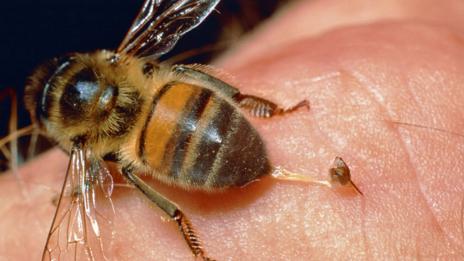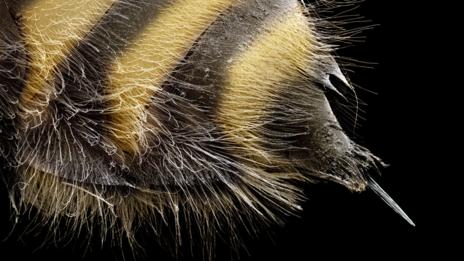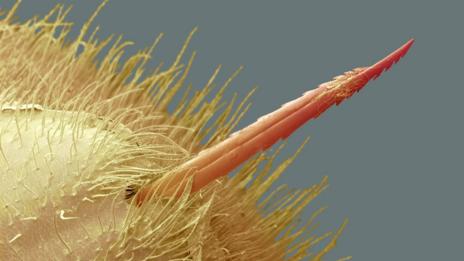Ellie Lobel was ready to die. Then she was attacked by bees. Christie Wilcox hears how venom can be a saviour.
"They were in my hair, in my head, all I heard was this crazy buzzingCaused by corkscrew-shaped bacteria called Borrelia burgdorferi, which enter the body through the bite of a tick, Lyme disease is diagnosed in around 300,000 people every year in the United States. It kills almost none of these people, and is by and large curable – if caught in time. Antibiotics can wipe out the bacteria quickly before they spread through the heart, joints and nervous system.
But back in the spring of 1996, Ellie didn’t know to look for the characteristic bull’s-eye rash when she was bitten – she thought it was just a weird spider bite. Then came three months with flu-like symptoms and horrible pains that moved around the body. Ellie was a fit, active woman with three kids, but her body did not know how to handle this new invader. She was incapacitated. “It was all I could do to get my head up off the pillow,” Ellie remembers.
Her first doctor told her it was just a virus, and it would run its course. So did the next. As time wore on, Ellie went to doctor after doctor, each giving her a different diagnosis. Multiple sclerosis. Lupus. Rheumatoid arthritis. Fibromyalgia. None of them realised she was infected with Borrelia until more than a year after she contracted the disease – and by then, it was far too late.
“I just kept doing this treatment and that treatment,” says Ellie. Her condition was constantly worsening. She describes being stuck in bed or a wheelchair, not being able to think clearly, feeling like she’d lost her short-term memory and not feeling “smart” anymore. “I would get better for a little while, and then I would just relapse right back into this horrible Lyme nightmare. And with every relapse it got worse.”

So she packed up everything and moved to California to die. And she almost did.
Less than a week after moving, Ellie was attacked by a swarm of Africanised bees.
Swarm saviour
Ellie was in California for three days before her attack. “I wanted to get some fresh air and feel the sun on my face and hear the birds sing. I knew that I was going to die in the next three months or four months. Just laying there in bed all crumpled up… It was kind of depressing.”
At this point, Ellie was struggling to stand on her own. She had a caregiver on hand to help her shuffle along the rural roads by her place in Wildomar, the place where she had chosen to die.
She was just standing near a broken wall and a tree when the first bee appeared, she remembers, “just hitting me in the head”. “All of a sudden – boom! – bees everywhere.”

(Credit: SPL)
Ellie, like 1–7% of the world’s population, is severely allergic to bees. When she was two, a sting put her into anaphylaxis, a severe reaction of the body’s immune system that can include swelling, nausea and narrowing of the airways. She nearly died. She stopped breathing and had to be revived by defibrillation. Her mother drilled a fear of bees into her to ensure she never ended up in the same dire situation again.
Strong sting
Bees – and some other species in the order Hymenoptera, such as ants and wasps – are armed with a potent sting. This is their venom, and it’s a mixture of many compounds. Perhaps the most important is a tiny 26-amino-acid peptide called melittins, which is responsible for the feeling of burning.
When we experience high temperatures, our cells release inflammatory compounds that activate a special kind of channel, TRPV1, in sensory neurons. This ultimately causes the neurons to send a signal to the brain that we’re burning. Melittin subversively makes TRPV1 channels open by activating other enzymes that act just like those inflammatory compounds.

“I just went limp. I put my hands up and covered my face because I didn’t want them stinging me in the eyes… The next thing I know, the bees are gone.”
When the bees finally dissipated, her caregiver tried to take her to the hospital, but Ellie refused to go. “This is God’s way of putting me out of my misery even sooner,” she told him. “I’m just going to accept this.
“I locked myself in my room and told him to come collect the body tomorrow.”
But Ellie didn’t die. Not that day, and not three to four months later.
“I just can’t believe that was three years ago, and I just can’t believe where I am now,” she tells me. “I had all my blood work done. Everything. We tested everything. I’m so healthy.”
She believes the bees, and their venom, saved her life.

“Over millions of years, these little chemical engineers have developed a diversity of molecules that target different parts of our nervous system,” says Ken Winkel, Director of the Australian Venom Research Unit at the University of Melbourne. “This idea of applying these potent nerve toxins to somehow interrupt a nervous disease has been there for a long time. But we haven’t known enough to safely and effectively do that.”
Despite the wealth of history, the practical application of venoms in modern therapeutics has been minimal. That is, until the past 10 years or so, according to Glenn King at the University of Queensland in Brisbane, Australia. In 1997, when Ellie was bouncing around from doctor to doctor, King was teasing apart the components of the venom from the Australian funnel-web, a deadly spider. He’s now at the forefront of venom drug discovery.

Over the course of the 20th Century, suggested venom treatments for a range of diseases have appeared in scientific and medical literature. Venoms have been shown to fight cancer, kill bacteria, and even serve as potent painkillers – though many have only gone as far as animal tests. At the time of writing, just six had been approved by the US Food and Drug Administration for medical use (one other – Baltrodibin, adapted from the venom of the Lancehead snake – is not FDA approved, but is available outside the US for treatment of bleeding during operations).
The more we learn about the venoms that cause such awful damage, the more we realise, medically speaking, how useful they can be. Like the melittin in bee venom.
Molecular moves
Melittin does not only cause pain. In the right doses, it punches holes in a cell’s protective membranes, causing cells to explode. At low doses, melittin associates with the membranes, activating lipid-cutting enzymes that mimic the inflammation caused by heat. But at higher concentrations, and under the right conditions, melittin molecules group together into rings creating large pores in membranes, weakening a cell’s protective barrier and causing the entire cell to swell and pop like a balloon.

For example, researchers at the Washington University School of Medicine in St Louis, Missouri, have found that melittin can tear open HIV’s protective membrane without harming human cells. This envelope-busting method also stops the virus from having a chance to evolve resistance. “We are attacking an inherent physical property of HIV,” Joshua L Hood, the lead author of the study, said in a press statement. “Theoretically, there isn’t any way for the virus to adapt to that. The virus has to have a protective coat.” Initially envisioned as a prophylactic vaginal gel, the hope is that melittin-loaded nanoparticles could someday be injected into the bloodstream, clearing the infection.
Tall tale
But could bees really have cured Lyme disease? Ellie is the first to admit that her tale sounds a little tall. “If someone were to have come to me and say, ‘Hey, I’ll sting you with some bees, and you’ll get better’, I would have said, ‘Absolutely not! You’re crazy in your head!’” But she has no doubts now.

For three days, she was in pain. Then, she wasn’t.
“I had been living in this… I call it a brown-out because it’s like you’re walking around in a half-coma all the time with the inflammation of your brain from the Lyme. My brain just came right out of that fog. I thought: I can actually think clearly for the first time in years.”
With a now-clear head, Ellie started wondering what had happened. So she did what anyone else would do: Google it. Disappointingly, her searches turned up very little. But she did find one small 1997 study by scientists at the Rocky Mountain Laboratories in Montana, who’d found that melittin killed Borrelia. Exposing cell cultures to purified melittin, they reported that the compound completely inhibited Borrelia growth. When they looked more closely, they saw that shortly after melittin was added, the bacteria were effectively paralysed, unable to move as their outer membranes were under attack. Soon after, those membranes began to fall apart, killing the bacteria.

Her bees live in a “bee condo” in her apartment. She doesn’t raise them herself; instead, she mail orders, receiving a package once a week. To perform the apitherapy, she uses tweezers to grab a bee and press it gently where she wants to be stung. “Sometimes I have to tap them on the tush a little bit,” she says, “but they’re usually pretty willing to sting you.”
She started on a regimen of 10 stings a day, three days a week: Monday, Wednesday, Friday. Three years and several thousand stings later, Ellie seems to have recovered. Slowly, she has reduced the number of stings and their frequency – just three stings in the past eight months, she tells me (and one of those she tried in response to swelling from a broken bone, rather than Lyme-related symptoms). She keeps the bees around just in case, but for the past year before I talked to her, she’d mostly done just fine without them.
Complex cocktails
Rare cases like Ellie’s are a reminder of the potent potential of venoms. But turning folk knowledge into pharmaceuticals can be a long and arduous process. “It could take as long as 10 years from the time you find it and patent it,” says King. “And for every one that you get through, 10 fail.”

Ellie has partnered with a bee farm that uses a special electrified glass plate to extract venom. As the bees walk across the plate on the way to and from their hive, harmless currents stimulate the bees to release venom from their abdomens, leaving teeny little droplets on the glass, which are later collected. Ellie says it takes 10,000 bees crossing that plate to get 1 gram of venom (other sources, such as the Food and Agriculture Organization of the UN, quote 1 million stings per gram of venom), but “those bees are not harmed”.
She sends some of the venom she purchases – which, due to the cost of the no-harm extraction method she uses, she says is “more expensive than gold” – to Eva Sapi, Associate Professor of Biology and Environmental Science at the University of New Haven, who studies Lyme disease.
Sapi’s research into the venom’s effects on Lyme bacteria is ongoing and as yet unpublished, though she told me the results from preliminary work done by one of her students look “very promising”. Borellia bacteria can shift between different forms in the body, which is part of what makes them so hard to kill. Sapi has found that other antibiotics don’t actually kill the bacteria but just push them into another form that is more dormant. As soon as you stop the antibiotics, the Borellia bounce back. Her lab is testing different bee venoms on all forms of the bacteria, and so far, the melittin venom seems effective.

She stresses that much more data is needed before any clinical use can be considered. “Before jumping into the human studies, I would like to see some animal studies,” she says. “It's still a venom.” And they still don’t really know why the venom works for Ellie, not least because the exact cause of post-treatment Lyme disease symptoms remains unknown. “Is it effective for her because it’s killing Borellia, or is it effective because it stimulates the immune system?” asks Sapi. It’s still a mystery.

No one knows exactly how many venomous species there are on this planet. There are venomous jellyfish, venomous snails, venomous insects, even venomous primates. “When people ask me what’s the best way to convince people to preserve nature, your weakest argument is to talk about how beautiful and wonderful it is,” says Bryan Fry. Instead, he says, we need to emphasise the untapped potential that these species represent. “It’s a resource, it’s money. So conservation through commercialisation is really the only sane approach.”
Ellie couldn’t agree more. “We need to do a lot more research on these venoms,” she tells me emphatically, “and really take a look at what’s in nature that’s going to help us.”
This is an edited version of an article originally published by Mosaic, and is reproduced under a Creative Commons licence. For more about the issues around this story, visit Mosaic’s website here.

ไม่มีความคิดเห็น:
แสดงความคิดเห็น